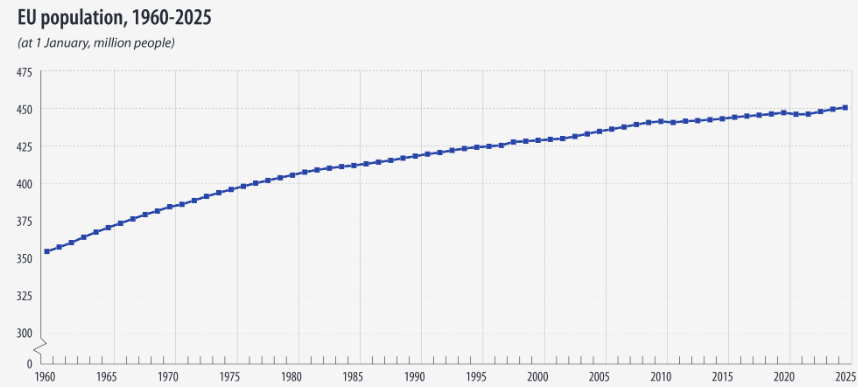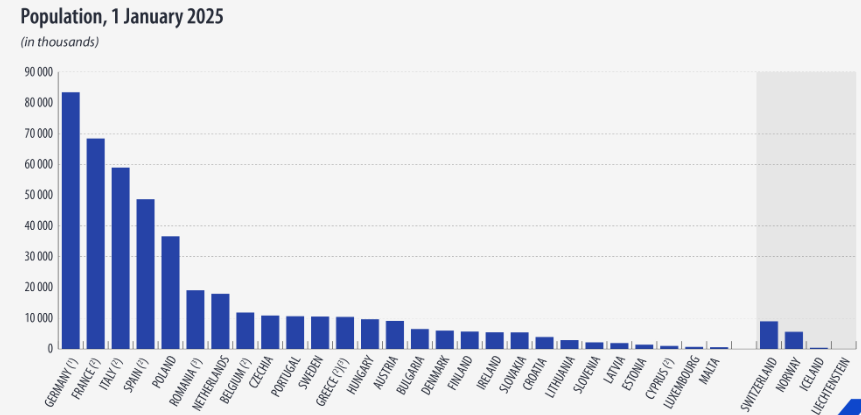The EU population reached 450.4 million on 1 January 2025, marking the fourth consecutive year of growth after a pandemic-related decline in 2021. Driven largely by post-COVID-19 migration, the increase of over 1 million people reflects shifting demographic dynamics. Germany, France, and Italy remain the most populous nations, while countries like Malta, Ireland, and Luxembourg recorded the fastest growth. In contrast, Latvia, Hungary, and Poland saw population declines. Over the long term, the EU has grown by nearly 96 million since 1960, though the growth rate has slowed significantly in recent decades.
EU Population Rises Again in 2025, Reaching 450.4 Million
The population of the European Union reached 450.4 million people on 1 January 2025, marking an increase of 1,070,702 residents compared to the previous year. This uptick continues a trend of four consecutive years of growth, following a significant decline in 2021 due to the impact of the COVID-19 pandemic.

According to data released today by Eurostat, the resurgence in EU population figures is primarily driven by increased migration patterns that have intensified since the lifting of pandemic-related restrictions. Since 2012, natural population change in the EU has been negative — meaning more deaths than births — but this has consistently been offset by a positive net migration.
When viewed over a longer timeline, the EU population has grown from 354.5 million in 1960 to 450.4 million in 2025 — an increase of 95.9 million people over 65 years. However, the pace of growth has slowed in recent decades. During the 1960s, the EU saw average annual increases of about 3 million people, while from 2005 to 2024, growth slowed to an average of 0.9 million people per year.
Population growth across EU member states in 2025 was not uniform. Germany remained the most populous member state, with 83.6 million inhabitants, accounting for approximately 19% of the EU’s total population. It was followed by France (70.1 million, 15%) and Italy (59.1 million, 13%). Together, these three countries make up nearly 47% of the entire EU population.

Spain, Poland, Romania, the Netherlands, and Belgium were among the next most populous countries. At the other end of the spectrum, Malta had the smallest population in the EU, with just 0.6 million people.
Despite overall EU population growth, eight countries saw a decline between January 2024 and January 2025. Latvia experienced the sharpest drop with a crude population change rate of -9.9 per 1,000 inhabitants, followed by Hungary (-4.7), and Poland and Estonia (both -3.4).
On the positive side, 19 EU member states experienced population growth. Malta recorded the highest rate with +19.0 per 1,000 people, driven likely by its pro-immigration policies and economic opportunities. Ireland and Luxembourg also posted substantial growth, with rates of +16.3 and +14.7 per 1,000, respectively.
The population distribution chart for January 2025 clearly illustrates the demographic imbalance across the continent. While countries like Germany and France dominate in terms of size, many Eastern European and Baltic nations are facing declining populations due to emigration and low birth rates.
In the broader context, these shifts highlight a growing reliance on migration as a key driver of demographic sustainability within the EU. With natural population growth remaining negative, future population stability and economic vitality are increasingly tied to effective migration policies.
Disclaimer:
EU population article is based on publicly available data published by Eurostat and includes information and interpretations derived from official population statistics as of 1 January 2025. While every effort has been made to ensure accuracy, the figures and conclusions presented may be subject to revision as new data becomes available.
The content is intended for informational and analytical purposes only and should not be construed as official demographic forecasts or policy recommendations. Readers are encouraged to consult Eurostat or relevant national statistical authorities for more detailed or updated information.

